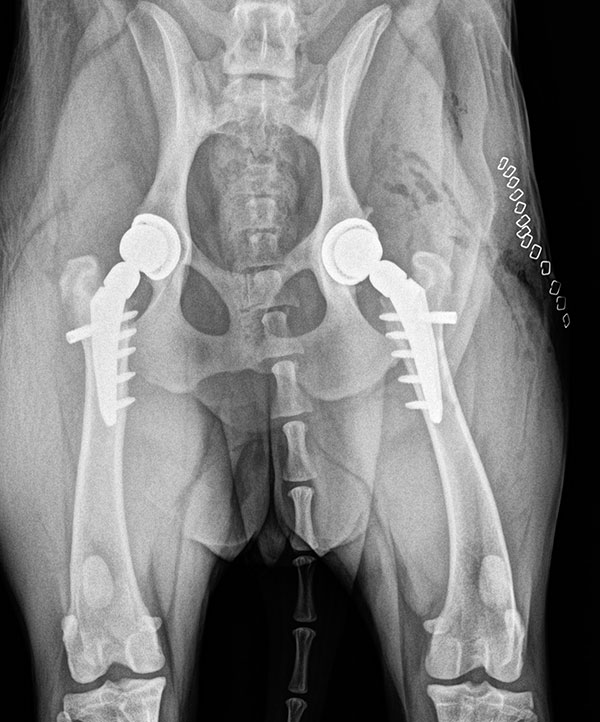Total hip replacement (THR) may be a great option for a pet who has pain due to hip arthritis or an old injury of the joint. The procedure has evolved in our companions in the same way it has in human medicine. Improvement in techniques, materials, and growing experience with the procedure for veterinary surgeons has led us to a point where the procedure reliably eliminates pain and dysfunction and makes an enormous difference in quality of life for a pet suffering from hip pain.

This page will give you information about hip replacement in dogs and cats but, of course, feel free to call or schedule a consultation at Spry Companions to get more specific information about whether it would be a good option for your pet.
Conditions Treated with Hip Replacement
The most common reason for hip replacement is hip arthritis secondary to hip dysplasia. Often, dogs can be severely affected by arthritis in the hips, even at a young age, because the looseness of the hips from hip dysplasia will cause cartilage wear in the joint. Cats can also have hip dysplasia and arthritis. Signs are harder to identify in cats and they tend to just become less active, hide, or become reluctant to jump onto things like they normally would.
Hip replacement is also used to treat pain and arthritis in a hip because of previous injury to the hip. This often is due to old acetabular (cup) fracture or fractures of the femoral head and neck. Small dogs can have a problem called avascular necrosis of the femoral head (Legg-Perth’s disease). This is a congenital problem which results in loss of bone density of the femoral head and progressive arthritis and pain at a young age. Hip replacement can be used to alleviate this pain and dysfunction.
Lastly, dislocations of the hip which occur secondary to arthritis are best treated with hip replacement. Although the best treatment for a traumatic dislocation of a normal hip is surgical or non-surgical reduction (putting it back in place), attempts to put abnormal hips back in place generally meet with failure.
Alternatives
There are always alternatives to a hip replacement. The two primary treatment options would be symptomatic management of the osteoarthritis/pain and a surgical procedure called a femoral head and neck excision (FHNE), often referred to and is synonymous with a femoral head ostectomy (FHO). These don’t provide the same function and comfort as a hip replacement but are reasonable alternatives in the right cases.
Symptomatic management is most appropriate when the clinical signs are intermittent and not severe. This involves the use of medications (similar to ibuprofen, but specifically for dogs and unlike ibuprofen, safer for dogs), physical therapy, and alterations in activity. If a pet needs these medications often and still has pain that is affecting their quality of life or limiting their activity, surgical intervention is usually warranted.
Femoral head and neck excision is a surgery where the ball of the hip joint is removed. In severe cases of arthritis, it eliminates bone-on-bone contact in the joint and can improve comfort. However, the anatomy is altered after surgery. The two bones are connected only by scar tissue and muscle – there is no longer a joint present. Patients with this procedure won’t return to normal strength and comfort in the limb. The smaller and less active a patient is, the more acceptable the results of this surgery are. However, numerous studies have shown that femoral head and neck excision does not typically result in return to normal function on the limb even in small patients. Its primary advantage over total hip replacement is that it is significantly less expensive.
Implants and Procedure
At Spry we use the Kyon total hip replacement system. We have a high degree of confidence in this system. It is a cementless system that does not utilize “bone cement” in the placement of the implants. During a total hip replacement, surgeons replace the worn-out parts of the hip joint with artificial components made of metal, and ceramic. It’s like giving new life to a joint, utilizing a brand new set of parts to work smoothly again.
Recovery
For the first eight weeks following surgery, your companion’s activity should be restricted. THR patients should not be permitted to run, jump, use stairs, or play with other pets or even us. Outdoor activity is off limits other than short leash walks to urinate or defecate. We will guide you more regarding how to introduce walking and further activity. Your dog should be monitored closely and should be strictly confined to a small indoor area with non-slippery floors. This is crucial for a successful outcome and recovery and is the best way to limit post-operative complications. At the conclusions of the eight weeks, radiographs will be performed. These will be evaluated by your surgeon and guidance will be provided regarding introducing normal activity again.
Outcomes
The goal of a total hip replacement is to provide a pain-free hip joint, restore normal joint function, and to improve the quality of life in the majority of dogs. The success rate of THR is approximately 90-95%. The peak recovery time for a total hip replacement is 4-6 months following the surgical procedure.
